Top News
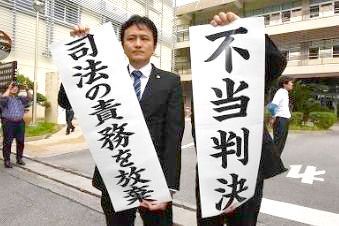
December 1, 2017 Ryukyu Shimpo
The Naha branch of the Fukuoka High Court handed down an appeal decision on November 30 for the “Battle of Okinawa Victim’s State Reparations Suit,” wherein a group of 66 victims and victim’s survivors are demanding an indemnity of 11 million yen per person and an apology for damage suffered during the aforementioned battle.
Chief Justice Toshiro Tamiya recognized Japanese soldier’s injurious behavior as well as wartime damage suffered by the plaintiffs such as post-traumatic stress disorder (PTSD), however he supported the decision of the Naha District Court that originally dismissed the suit which stated that based on Japan’s laws during the war, “Japan was not liable to pay reparations for exercising public authority,” and rejected the victim’s appeal. The citizens plan to appeal the decision to the Supreme Court.
In his ruling, Chief Justice Tamiya said of the damage caused by the Battle of Okinawa that, “The organized suicides by force under military rule is unique,” however he decided that all Japanese people suffered during the war, stating “the unique circumstances of the Battle of Okinawa does not constitute the grounds for demanding compensation and an apology.”
Meanwhile, the judge referenced the damage suffered by two of the plaintiffs, noting that, “it points to the existence of injurious behavior and forced suicides,” by the Japanese Imperial Army. Also, the PTSD suffered by many of the victims originate from the Battle of Okinawa and is suffered by man was recognized in this trial where it was not in the initial ruling.
However, the court ruled that there was an “absence of State liability,” as Japan was deemed not responsible for losses suffered before the enforcement of the “Act concerning State Liability for Compensation,” and therefore the responsibility for the damage suffered by the two plaintiff resided, “only with the soldiers as individuals.”
Regarding damage compensation, the plaintiffs’ allegations that, “we are trying to prevent an absurd situation where there is complete lack of compensation under the survivor support law,” and “the compensation system for private citizens is unequal,” went un-recognized.
Lead lawyer for the victims, Shigeru Zukeyama, said, “The absurdity of rejecting our claim while acknowledging extensive damage is an unjust decision.”
(English translation by T&CT and Sam Grieb)
Go to Japanese

November 23, 2017 Ryukyu Shimpo
On November 22 at the Okinawa Prefectural Government, the Asia Economic Strategy Section held a meeting and announced the establishment of seafood exports from Okinawa to Shanghai, China. The regulations imposed on Japanese food since the Fukushima Daiichi Nuclear Power Plant accident have been strict to maintain the safety of the food.
Fisheries marketing company Sanko Suisan and various agencies, have enabled rapid custom clearance procedures such as radioactivity inspection and issuance of multiple certificates on the same day.
With ANA’s Okinawa freight hub, exports of tuna such as yellowfin tuna and bigeye tuna will begin.
A fresh fish gets inspected at 5 a.m. and brought to Naha airport by 5 p.m. on the same day.
It can be transported to Pudong Airport in Shanghai during the night and delivered to restaurants in China by the evening of the following day.
For food exports to China, radiation tests, production certificates, and hygiene certificates are required.
Export of seafood has been especially difficult to get approval for because it requires freshness.
Now applicants can use the Ministry of Fishery’s electronic application for issuance of production certificates and receive the original copy at the Okinawa General Secretariat on the same day.
Issuance of hygiene certificate which normally takes about one week can be done by applying for it in advance.
Radiation tests can also be conducted on the same day. Related agencies worked together to speed customs clearance.
From February this year, transport tests were carried out five times.
On November 21, 300 kilos of tuna was transported for orders from China. Sanko Suisan aims for an export volume of 20 tons, a sales amount of 40 million yen in the fiscal year of 2018 and 50 tons and 100 million yen in the fiscal year of 2019.
In addition to tuna fished in Okinawa, they are also considering expanding exports of seafood such as Diamond squid and farm-raised Malabar grouper.
Sanko Suisan President Umazume(?) said, “We would like to strengthen the market in Okinawa with branding and raise the unit price to support the fisheries.”
Director of the Asia Economic Strategy Section Chief Hitoshi Nakaema said, “This is the first step in exporting fresh fish to China”.
He added that he hoped for further expansion of exports.
The prefecture is also accepting inquiries on the export of fresh fish to China by business operators in Okinawa. For inquiries, call 098 (866)2340.
(English translation by T&CT and Megumi Chibana)
Go to Japanese
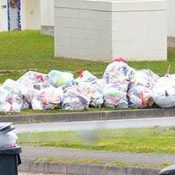
November 24, 2017 Ryukyu Shimpo
With the Okinawa Prefecture deciding to revoke the permit to treat industrial waste for the Kurashikikankyo Co. Ltd. in Okinawa City, which manages most of the U.S. military base waste, the bases are facing a waste treatment problem.
The U.S. Kadena Base announced on its official facebook page the suspension of the garbage collection for about seven to ten days from November 21.
The official page also strongly encourages base residents to work on recycling.
The Camp Foster offical facebook page also shared the announcement, calling for caution.
All the waste from the households and bulky waste are included in the suspension, and the announcement explains the reason for the suspension as “issues with the contract and license with the waste management facilities.”
It further requests not to leave garbage at the garbabge collection sites while also announcing that engineers on the base are working on solving the issue.
The waste from the U.S. military has been managed through two companies including the Kurashikikankyo Co. Ltd.
(English translation by T&CT and Sayaka Sakuma)
Go to Japanese

November 27, 2017 Ryukyu Shimpo
The International Human Rights Law Association (IHRLA), chaired by Shin Hae Bong, held its 29th annual meeting over two days starting on November 26 at Times Hall in Naha City. At this meeting, lawyers and researchers from around Japan discussed lawsuits concerning U.S. bases in Okinawa, such as the current lawsuit aimed at stopping new base construction in Henoko, and how these lawsuits relate to international human rights law. There was also a report addressing the Universal Periodic Review (UPR) of Japan’s government conducted by the United Nations Human Rights Council (UNHRC) at the meeting.
During the discussion on lawsuits Chuo University Professor Tadasu Watari said of the earlier Henoko lawsuit, “[the court] came to its conclusion without even one appeal addressing the severity of matters such as the worth of the environment that will be destroyed through land reclamation work.”
Kichiro Takagi, a defense lawyer in the third Kadena noise lawsuit, brought up the Supreme Court decision on the 1959 Sunagawa Case, which was the court’s basis for rejecting the request to halt U.S. aircraft flights. He said: “The Supreme Court overturned an initial decision that U.S. stationing [in Okinawa] was unconstitutional by citing the political question doctrine. It also set forth [in its decision] that U.S. stationing does not breach Article 9 of the Constitution.”
Takagi also criticized the Supreme Court because it has the authority to make big decisions, yet avoided doing so.
Participants from Okinawa and the rest of Japan provided their opinions of the UN’s UPR.
Director Masatoshi Sugiura of the Human Rights and Humanitarian Affairs Division of the Foreign Policy Bureau, Ministry of Foreign Affairs, addressed the UN’s recommendation that the Japanese government protect the human rights of Okinawans as an indigenous people. He said, “At this time the government recognizes the Ainu people as indigenous people.” Following this dismissal he continued, “Under the Constitution all are guaranteed equal rights.”
A representative of the All Okinawa Council for Human Rights (AOCHR) and professor at the University of the Ryukyus Jun Shimabukuro said that Okinawa researchers have come together and addressed the UPR by submitting a written report on four issues affecting Okinawa. He also pointed out that the Japanese goverment has not yet responded to Peru’s recommendation that it promote economic, social and cultural rights for the people of Okinawa.
Eiichi Hoshino, another representative of AOCHR and professor at the University of the Ryukyus, gave examples of citizens who oppose U.S. base construction being arrested, and explained that this violates their freedom of expression. Representing AOCHR, he reported on what actions the council is encouraging the UN to take.
(English translation by T&CT and Erin Jones)
Go to Japanese
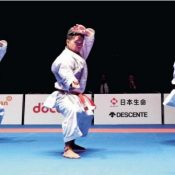
November 27, 2017 Ryukyu Shimpo
The Japan Men’s National Team 1 – Ryo Kiyuna, Arata Kinjo, and Takuya Uemura (of the Okinawa Ryuei Ryu Karate Kobudo Organization) went undefeated with five straight victories on the final day of the Karate 1 –Series A Okinawa international tournament hosted by the World Karate Federation November 26 at the Okinawa Prefectural Budokan in Naha.
They capped off their day by besting Japan’s National Team 2 to take the gold medal for Male Team Kata.
This is the first appearance in the Series A tournament for Kiyuna, Kinjo, and Uemura after winning three straight championships in the Premier League tournaments hosted in Okinawa from 2014-2016.
Kiyuna, who has also won three straight gold medals in the individual Male Kata, won the same category at this tournament as well, marking the fourth straight year that the group has won the championship in international tournaments hosted in Okinawa in both the individual and group categories.
In an interview after the tournament, Kiyuna said, “The fundamental skills honed with care in practice came to life [in the tournament].
I am very pleased to go undefeated in both the individual and group categories.”
The team also won the Male Team Kata at the Karate World Championship in their first appearance in October, 2016.
Reflecting on this Kinjo said of the recent competition, “The pressure was extreme due to the great expectation placed on us, but we found power in the cheering of our supporters.”
Uemura commented on his desire for further success, saying, “I want to continue working hard to catch up to and even surpass the senior team members Kiyuna and Kinjo.”
(English translation by T&CT and Sam Grieb)
Go to Japanese
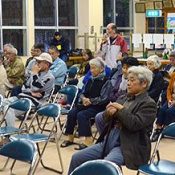
November 24, 2017 Ryukyu Shimpo
(Kunigami) In relation to the Okinawa Defense Bureau’s use of Oku Port in Kunigami as a spot from which to transport stone materials to be used in the construction of a new base in Henoko, Nago, on November 23, Oku Ward held an emergency assembly where a protest resolution opposing the use of Oku Port was passed unanimously.
Ward officials plan to draft the final text of the resolution at a meeting of on November 24 and to submit the resolution to the prefectural government and other official entities in the near future.
The ward’s resolution opposing the use of Oku’s port could have an impact on the transport of stone materials.
More than 40 people, representing one in four adults living in Oku, attended the assembly, and the resolution was approved to applause.
Ward head Moriya Itoman expressed his intent to participate in the protest actions, saying, “Ward residents are unanimous in their opposition to use of the port.
Until now, I had to refrain due to my position as ward head, but now I can participate [in the protest actions] without hesitation.”
At the assembly, ward residents spoke one after another about their opinions on the use of Oku Port in connection to the new base construction.
Tetsuya Kinjo, age 59, expressed anger, saying, “If so many trucks come to the port in this small village with its abundant nature, there is no doubt that traffic will become a mess.
I am resolutely opposed [to the use of Oku Port].”
On November 7, a representative from the Okinawa Defense Bureau visited the Oku Community Center and explained to ward head Itoman that the Bureau would transport stone materials from Oku Port starting in early November.
On November 10, a Bureau representative told Itoman by phone that the Bureau would use Oku Port on November 13. At that time, Itoman told the representative he wanted the Bureau to wait until a ward assembly was held, but the representative responded that the work would be carried out at the responsibility of the Okinawa Defense Bureau.
On November 13, the Okinawa Defense Bureau, ignoring the wishes of the ward leadership, pushed forward with oversea transport of materials from Oku Port, while Oku residents engaged in protest action at the port.
(English translation by T&CT and Sandi Aritza)
Go to Japanese
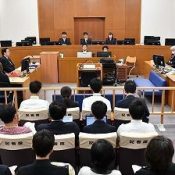
November 24, 2017 Ryukyu Shimpo Digital Edition
The closing arguments and sentencing recommendations for the 33-year old ex-Marine accused of murder and rape resulting in death of an Okinawan woman back in April while working as a civilian on a U.S. military base began at 10 a.m. on November 24 at the Naha District Court (Judge Toshihiro Shibata presiding).
While the defendant has pled not guilty to murder, the prosecution has recommended a life sentence arguing, “The defendant’s crime should be recognized has having an intent to kill.”
Meanwhile, the victim’s parents have asked the court to consider capital punishment, while the defendant’s lawyer argued, “A life sentence would be too harsh. A definite term sentence is more suitable.”
At the end of the proceedings, the defendant made a statement, saying, “I am not a bad person. I did not mean for any of this to happen.”
The defendant was silent throughout the trial, however during closing arguments the prosecutor indicated the statements the defendant made to the police shortly after arrest, where he admitted to both strangling the victim as well as stabbing her in the neck, “making it clear that the defendant acted knowing that the danger of his actions would lead to a loss of life.”
During sentencing recommendations, the prosecution was “considering the death penalty,” due to a lack of apology or remorse from the defendant, but also took into consideration the defendant’s voluntary admission to police and his lack of a previous criminal record in Japan.
The defendant’s counsel argued that it could not be discounted that the victim died after striking her head on the ground when the defendant carried to and threw down her body at the scene of the crime, which does not constitute murder.
The defendant had pled not guilty to the charge of murder despite having already pled guilty to rape resulting in death and abandoning the victim’s body, saying he “had no intention of killing her.”
(English translation by T&CT and Sam Grieb)
Go to Japanese
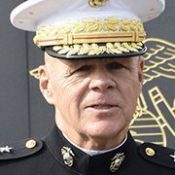
November 23, 2017 Ryukyu Shimpo
On November 21 Commandant of the U.S. Marine Corps Robert Neller spoke about the fatal collision on November 19 due to a Marine Corps serviceman driving under the influence of alcohol.
He said: “Well, our condolences go to the family of the individual who was killed. And I also have great sympathy for the Marine. I’m sure that was not his intent.”
In Ryukyu Shimpo’s interview with Neller, he showed sympathy for the Marine, but did not mention the serviceman’s responsibility in drinking before the fatal collision.
Nor did he make any reference to future preventative measures or cracking down on discipline.
An Okinawan official commented on Neller’s statement, “He should have issued an apology first and foremost, instead [his words] were extremely ill-suited [to the situation].”
During his interview Neller said of the accident, “it’s being investigated, and the Japanese courts, based on the Status of Forces Agreement, will adjudicate whatever happens to him. And we’ll continue to cooperate with the investigation.”
Neller spoke further of the accident: “Obviously, we wish it hadn’t happened. But it did. And I guess I would ask the Okinawan people, and the people of Japan, to understand that there are 22, 23 thousand Marines stationed in Japan and Okinawa.
And this one individual appears to have made a very bad mistake.”
He went on, “And I think most people I know, living on Okinawa, may understand that the great, great, great majority of Americans are good neighbors, and are respectful of the culture, and conduct themselves properly when they’re overseas.”
(English translation by T&CT and Erin Jones)
Go to Japanese
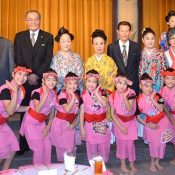
November 23, 2017 Ryukyu Shimpo
Ryusou Bunka Sha and Arcone Co. Ltd. have made the 22nd of every month “Ryusou (Create Ryukyu) Day” in hopes of spreading Ryukyu culture, such as clothing and dance, to Okinawan citizens and transmitting it to the world.
The two groups will begin working on various endeavors together.
On November 22, a commemoration party was held at The Naha Terrace in Naha City as a kickoff event with about eighty participants.
The word “Ryusou,” meaning “create Ryukyu,” was coined in hopes of creating and transmitting something new by interacting with Ryukyu culture.
A wide variety of groups, such as Ryukyu dance groups and medical corporations are participating in the Ryusou Day efforts.
Regarding the establishment of Ryusou Day, Ryusou Bunka Sha (Create Ryukyu Culture Company) representative Toshiko Chinen said, “We hope to see people openly wear Ryukyu clothing on a daily basis and for the culture to spread to the world.”
When she was young, Chinen admired how her grandmother lived adorned in pretty Ryukyu clothing.
She took up Ryukyu dance as an adult and as her feelings toward Ryukyu culture grew stronger, she conceived the idea, “A Day to Transmit Ryukyu Culture.”
About forty years have passed and she now works towards that goal with the help of Arcone Co. Ltd. representative Akiko Hasumi and potter Kinzo Norimatu, who both hold the same ambitions.
Because Chinen believes “many people are not familiar with Ryukyu clothing,” she plans to hold events every month on Ryusou Day on the 22nd where people can have fun drinking tea as they stroll down the street in Ryukyu clothing.
She calls on people to participate and emphasized, “I want many people to see and feel Ryukyu culture. It is by no means a far-fetched idea.
(English translation by T&CT and Chelsea Ashimine)
Go to Japanese
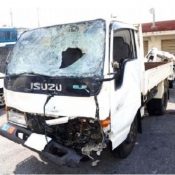
November 20, 2017 Ryukyu Shimpo
On November 19 the Naha Police apprehended a 21-year-old lance corporal of the U.S. Marines who was operating a two-ton military truck while under the influence of alcohol.
This Camp Kinser-based Marine collided the military vehicle with a small truck and killed its driver, a 61-year-old male company employee from Naha City.
The Naha Police arrested the Marine on charges of negligent driving resulting in death and driving under the influence of alcohol.
According to the Naha Police the Marine has confessed to the charges.
His blood-alcohol content (BAC) was detected by a breath test to be approximately triple the legal limit in Japan, which is 0.15 milligrams per liter (or about 0.03 percent BAC), setting his BAC somewhere around 0.09 percent.
The Naha Police will continue to investigate, with the prospect of changing the Marine’s charge to dangerous driving causing death.
The offense for which the Marine was arrested took place around 5:25 a.m. on November 19.
As the Marine was heading south going straight on National Route 58 in Tomari, Naha City, he collided with the small truck and its driver taking a right turn heading from Matsuyama toward Asato, Naha City.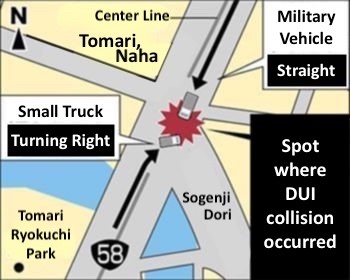
The man who had been driving the small truck is suspected to have died of traumatic chest injuries.
He was taken away in an ambulance, but died at 6:55 a.m. the same morning.
The suspect also suffered an abrasion to the left side of his lower back.
Through eyewitness testimony it seems that the small truck’s driver was making a right turn when the Marine ignored the red light, entered the intersection, and collided with the other vehicle.
Okinawa Prefectural Police received unofficial communication from the U.S. military after the accident.
According to the Naha Police it is possible that the suspect was operating the military vehicle without permission.
Since Okinawan police arrested the suspect, under the U.S.-Japan SOFA he is not to be extradited.
As a safety precaution the Naha Police transported the military vehicle from the collision site to the Naha Police Station.
After noon on November 19 the U.S. military recovered the vehicle, as it is property of the U.S. military.
According to the Naha Police the on-the-spot and initial investigations have been concluded, so the removal of the military vehicle will not be a significant hindrance to their ongoing investigations.
(English translation by T&CT and Erin Jones)
Go to Japanese

November 21, 2017 Ryukyu Shimpo
“Give me a break!” On the morning after a drunk driving fatality in Naha caused by a U.S. Marine stationed in Okinawa, Okinawa Governor Takeshi Onaga let fly one candid reprimand after another at Lt. General Lawrence Nicholson, the ranking military leader in Okinawa, as he stood before him. As the Governor protested that “You can’t be trusted with anything,” the General stood still with a stern expression.
The exchange took place in the Governor’s reception room on the 6th floor of the prefectural office. When Governor Onaga appeared from the media scrum, General Nicholson and Consul General Joel Ehrendreich bowed their heads toward him.
The Governor then read from a prepared statement. “Even if I were to say, ‘I demand that you enforce the law of the land, and take steps to prevent this from reoccurring,’ the worn down people of Okinawa would not believe a word of it. I can hardly say you have been ‘good neighbors.’ The people of Okinawa say, ‘Give me a break!’”
Governor Onaga and Lt. General Nicholson stood about a meter apart, with an interpreter off to the side. While the Governor spoke, occasionally the General would respond with small nods. When the Governor handed over the protest letter, the General accepted it with a bow.
After straightening up, Lt. Gen. Nicholson said, “While we have taken various measures to improve things, our efforts have been insufficient. I apologize from the bottom of my heart,” bowing deeply as the cameras flashed.
“We want you to understand how we feel.” After taking a seat, Governor Onaga emphasized this referring to the hardships that continue to be forced on Okinawa following the Battle of Okinawa. At one point, after prefacing a rhetorical questions with “I don’t need a reply,” the Governor posited, “The people of Okinawa are fed up. Where should they go to vent those emotions?”
Lt. Gen. Nicholson listened to the Governor’s words without taking notes, stressing that, “we will strive to lessen the burden imposed by the bases.” After a deep sigh by the General, the meeting was over. The scheduled 30 minute meeting lasted a little over 10 minutes. Ehrendreich said not a word, and watched the back of the Governor as he left the room.
(English translation by T&CT and Sam Grieb)
Go to Japanese












 Webcam(Kokusai Street)
Webcam(Kokusai Street)


